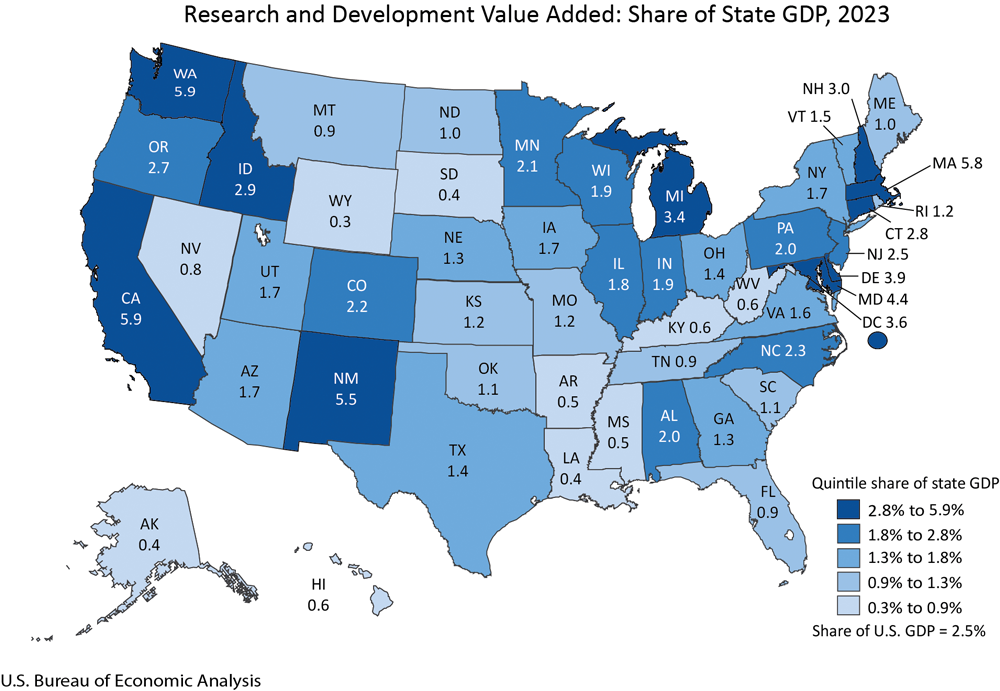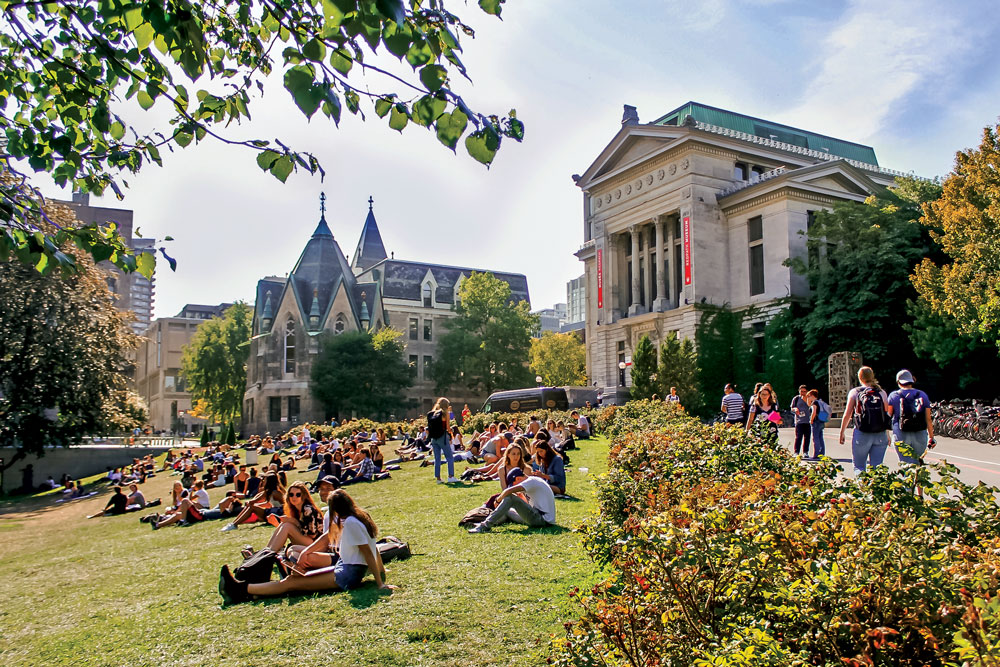It’s hard to argue with the career, R&D and thought leadership of Great Lakes higher education institutions, providing brainpower and innovation to fuel the fortunes of competitive employers and startups alike.
As of the 2022-2023 academic year, there were 3,896 degree-granting post-secondary institutions in the United States. The eight states in the Great Lakes region accounted for more than one-quarter of them (27.2%), led by New York (286), Pennsylvania (178) and Ohio (156). But wait, there’s more: Between them, Ontario (155) and Quebec (244) bring the Great Lakes higher education institutional roster to a grand total of 1,461 colleges and universities.
Travel the educational waterfront of this world region and you’ll find institutions from Carleton College in Minnesota to Carleton University in Ottawa, McGill in Montreal to Notre Dame in Indiana. You’ll encounter the giants of the Big 10 as well as the little schools with big influence that dot the Great Lakes region with nodes of intellectual firepower.
The Great Lakes Higher Education Consortium (GLHEC) was formed five years ago with funding from the United States Mission in Canada to the Council of the Great Lakes Region (CGLR, based in Toronto and in Cleveland, Ohio). Founding institutions include McGill University, Queen’s University and the University of Toronto in Canada and the University of Illinois System, University of Wisconsin and University of Michigan in the United States. In announcing a new strategic plan in 2024, the consortium cited its “Great Lakes, Great Minds” report, noting that 19 of the world’s top 100 universities are Great Lakes institutions, one-third of the top 100 engineering schools in the U.S. and Canada are in the region, and 15% of the world’s top 100 medical research schools call the region home.
“The region’s institutions are poised to lead complex fields, notably advanced manufacturing and logistics, AI, semiconductors and many other domains,” the GLHEC stated. “But, while the combined strengths and assets of these world-class institutions are well-known and clearly exceptional, they remain largely disconnected and untapped from a region-building perspective. The urgency to change this is growing, especially with respect to addressing talent gaps through student development and mobility as well as the region’s performance with respect to converting science into innovations and creating new businesses that drive regional commerce, job creation and international trade.”

“We are not simply preparing students for today’s workforce. We are cultivating the innovators, engineers and leaders who will future-proof the Great Lakes and ensure it remains globally competitive.”
— Vance Badawey, President and CEO, Council of the Great Lakes Region
Those new businesses have an enormous ecosystem at hand: If it were a country, the GLHEC said, the Great Lakes region would be the world’s third largest economy, supporting over 50 million jobs with an estimated annual economic output of US$6 trillion.
Vance Badawey, a longtime corporate strategy consultant and a former Member of Parliament in Canada, in September 2025 was named the new president and CEO of the Council of the Great Lakes Region, whose board includes prominent experts and program directors from York University in Toronto and Case Western Reserve University in Cleveland. He says the vision of the organization is to “position this region as the world’s leading model for sustainable economic growth and integrated binational collaboration.” And higher education has an important role to play.
“The Great Lakes Higher Education Consortium has an extraordinary opportunity to align the talent and research capacity of our universities and colleges with the transformational challenges of our time,” he says in an email. “I see the focus turning toward building cross-border, industry-connected programs in advanced and green automotive manufacturing, artificial intelligence, digital logistics, freshwater innovation and climate-smart infrastructure.”
By doing so, he says, “we are not simply preparing students for today’s workforce. We are cultivating the innovators, engineers and leaders who will future-proof the Great Lakes and ensure it remains globally competitive. Education, research, and workforce training must be the foundation of a long-term strategy for regional resilience and prosperity.”
Signs that this foundation is strong can be found on hundreds of campuses. For starters, check out these recent highlights from some of the founding members of the GLHEC:
McGill University,
MontrEal, QuEbec
Researchers in McGill’s Department of Mechanical Engineering have discovered a safe and low-cost method of engineering living materials such as tissues, organs and blood clots, the university reports. “By simply vibrating these materials as they form, scientists can dramatically influence how strong or, weak they become. The findings could have a range of innovative applications, including in organ transplants, wound healing and regenerative medicine” as well as advanced medical devices. Aram Bahmani, study co-author and Yale postdoctoral fellow, conducted the research at McGill as a PhD student with Associate Professor Jianyu Li’s Biomaterials Engineering lab. “What makes this especially exciting is that our method is non-invasive, low-cost and easy to implement,” Bahmani said in a university release. “It does not rely on expensive machines or complex chemicals, meaning it could one day be built into portable medical devices, like a hand-held tool to stop bleeding, or a smart bandage that speeds up healing.”
Queen’s University,
Kingston, Ontario
A September release from the university highlights efforts by researcher and Ryan Grant, associate professor in electrical and computer engineering at the university’s Ingenuity Labs Research Institute, to bring Canada up to par in the world of supercomputers, a field in which he excelled while working with Sandia National Laboratories in New Mexico. “As of September 2024, Canada’s most powerful supercomputer ranks 123rd in the world,” the Queen’s Gazette reported. “This places Canada as the only G7 nation without a supercomputer in the Top 50. Once the United Kingdom completes its upgrades, Canada will be the only G7 country without a supercomputer in the Top 25.”
But Grant sees public-private partnership as the way forward. “Opening supercomputing to industry could have an immense impact on Canada’s economy,” he told the publication. “U.S. studies show a $43 return for every dollar invested, while in Europe it’s closer to $60:$1. For Canada, the benefits to productivity and competitiveness could be huge, and allow us to keep up and even surpass current world leaders in the space. With enough time to train a pipeline of made-in-Canada supercomputer experts, we can be caught up in only a few years.” And geography favors Eastern Ontario, he said. “Kingston is centrally located between several large centers of government and industry — Toronto, Montreal, and Ottawa — putting us in an ideal location,” he said, backed by a team of 18 he’s assembled at the university and called the Computing at Extreme Scale Advanced Research (CAESAR) lab.
University of Toronto
The 2025 NTU World University Rankings in September named the University of Toronto No. 4 globally among 1,200 ranked institutions and more than 2,000 considered. Among public universities, U of T ranked second worldwide and was the top public university in North America. U of T ranked among the top 50 globally in four of six broad academic fields and first in Canada in each of those four fields: medicine (second globally); social sciences (fourth); life sciences (12th); and natural sciences (29th). It also ranked in the global top 10 in five subjects: clinical medicine (second); neurosciences and behaviour (third); social sciences, general (fourth); psychiatry and psychology (fourth); and biology and biochemistry (ninth). “This ranking reflects the University of Toronto’s world-leading strength in generating new discoveries and knowledge that are making an impact in Canada and around the globe,” said Leah Cowen, U of T’s vice-president, research and innovation, and strategic initiatives.

University of Illinois System
Spring 2025 saw the 20th Americas Competitiveness Exchange (ACE) bring 50 delegates from around the world to Illinois. ACE is a program of the Organization of American States (OAS), which fosters conversations across 35 independent states of the Americas focusing on democracy, human rights, security and development. The University of Illinois System was a linchpin as the weeklong event explored the state’s assets, talent and economic development progress in such areas as quantum computing, AI, advanced manufacturing and agriculture, including stops at the University of Illinois Chicago (UIC) and University of Illinois Urbana-Champaign (UIUC) campuses as well as visits to Peoria and Naperville. U of I System Associate Vice President for Workforce Development and Community Engagement Jeannette Tamayo said the event garnered the most letters of interest and memoranda of understanding for future projects and partnerships ever executed during ACE. A release also noted that the U of I System-led Illinois Innovation Network (IIN), led by Tamayo as executive director, “played a key role in OAS and the federal government choosing Illinois for its most recent ACE edition. IIN’s public university-based hubs join with industry and communities on entrepreneurship, research and workforce development across the state.”
University of Wisconsin
In September, Bjorn Borgen, a native of Strum, Wisconsin, who went on to build a multibillion-dollar investment firm, announced on his 88th birthday a $25 million gift including a $5 million endowment to support experiential learning woven through the Department of Mechanical Engineering curriculum, and a $20 million gift to the Engineering the Future Capital Campaign Fund. “Through the $20 million gift, Borgen’s name will adorn the active learning wing of the Phillip A. Levy Engineering Center, the College of Engineering’s forthcoming new building,” said a university release, noting the space will be called the Bjorn Borgen Learning Commons. “I want to be part of this new phase of making the University of Wisconsin-Madison College of Engineering one of the top public engineering schools in the country and increasing student enrollment,” said Borgen, whose support of the mechanical engineering department has established the Borgen Design Fund, an endowed fund that enables hands-on learning activities and financial resources from first-year introductory courses through senior capstone experiences. “The Borgen ME Design Lab in the Mechanical Engineering Building now includes 3D printers, allowing students to rapidly prototype projects,” the university said. “The Borgen Design Competition encourages students to pursue ambitious entrepreneurial and community service projects. And the gift also supports student teams that compete nationally in robotics, aerospace, autonomous vehicle, racing events and more.”

